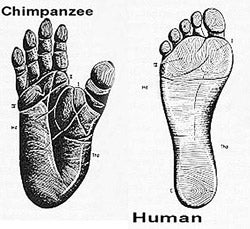show/hide words to know
Arboreal: moving through the trees.
Hallux: the big toe.
Lordosis: the inward curvature of the lower spine.
Toe off: pushing your foot off the ground during locomotion.
The ups and downs of two-legged walking
Bipedal locomotion, or walking on two legs, has many benefits:
1) It frees the hands for carrying tools and infants
2) It improves our ability to cool-off
3) It allowed our ancestors to see over the tall grasses
4) It allows us to travel long distances
However, these benefits of walking on two legs may make other activities more difficult.
One benefit of bipedal locomotion is that it frees the hands for carrying tools. Long before we used our hands to text on phones while walking, our hominin ancestors used their free hands to carry tools and even infants (as human babies cannot cling to their mothers).
However, the physical changes required for bipedal walking have negative effects on our bodies. For example, the curvature of the lower spine, or lordosis, makes it easier to balance on two legs. However, pain is frequently experienced when the back curves too much due to weakened muscles or illness. Lower back pain is very common. Perhaps your mom or grandpa suffers from back pain.
 We have very long legs with muscles ideally oriented for bipedal locomotion. Our big toe, or hallux, is positioned next to our other toes. This position is ideal for toeing off (pushing off with the toe) from the ground during walking. However, it also makes our ability to climb in trees clumsy and less efficient. Our big toe cannot grasp the branches as well as other primates. Being able to climb trees is important for both feeding on fruit and escaping predators.
We have very long legs with muscles ideally oriented for bipedal locomotion. Our big toe, or hallux, is positioned next to our other toes. This position is ideal for toeing off (pushing off with the toe) from the ground during walking. However, it also makes our ability to climb in trees clumsy and less efficient. Our big toe cannot grasp the branches as well as other primates. Being able to climb trees is important for both feeding on fruit and escaping predators.
It may seem odd that adaptations that make us better able to walk would make other activities, like climbing trees, more difficult. But it is important to understand that evolution is often a compromise between enhancing some traits while diminishing others.
Lumbar lordosis. The curvature (lordosis) of the lumbar spine of your lower back makes it easier to balance on two legs.









